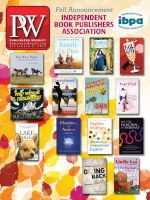Earlier this year, PW spoke with Javier Celaya, founder of Dosdoce.com and architect of the study “Profile of the Spanish Audiobook Market,” which primarily focused on titles published in Latin America and Spain. We reconnected with Celaya to discuss his new study, “Evolution of the Spanish Audiobook Market in the USA,” which was published in late August. Celaya’s findings in his new study are based on results from 15 out of the 20 publishers of audiobooks in Spanish in the U.S., and includes information from independent publishers about both children’s and adult books.
U.S. publishers produced close to 150 audiobook titles in Spanish in 2018 and plan to produce another 250 titles in 2019, the study found. The number of titles produced by American publishers does not include the output from Audible Studios, which has been publishing an average of 40–45 new Spanish audiobooks per month in 2019. Even with the Audible output, U.S. audio production of Spanish titles is only a fraction of the Spanish-language audiobooks available in the U.S. The main source for audiobooks in Spanish continues to be imports from Spain and Latin America. In the U.S. there are 6,500 audiobooks in Spanish, and that number is expected to reach 7,000 by the end of this year. “This increase in total output clearly demonstrates the interest of Spanish publishers to export these audiobooks to the different countries of Latin America,” Celaya points out, “as well as to the U.S. Hispanic market.” By the end of 2019, Celaya estimates that the number of Spanish-language audiobooks worldwide will hit 10,000, with overall sales between $8 million and $9 million.
Although the U.S. used to be the largest buyer of audiobooks in Spanish, Spain now claims that title, followed by Mexico, the U.S., and the rest of Latin America. Greater access to technology by consumers outside the U.S. and increased sales channels available in different parts of the world have given all publishers the opportunity to reach a greater number of consumers in international markets. Demand has not decreased in the U.S., but it is increasing much faster outside the U.S.
Regardless of the market, the leading sales channel for Spanish-language audio is subscription-based online services that sell directly to consumers—such as Audible, Kobo, Storytel, and Scribd. These were the most important sales channel in 2018 for two-thirds of American publishers, the study found. The remaining one-third of publishers reported unit sales platforms such as Google Play, iTunes, Downpour, or Libro.fm as their most important sales channels. All U.S. publishers agreed that streaming platforms such as Spotify, Deezer, Napster, and Apple Music were the least important sales avenues. After subscription services, the second-most common sales channel is single downloads, followed in the U.S. by libraries and streaming services such as Spotify.
In Latin America and Spain, libraries fall to fourth place and streaming services move up to third place. Unlike the U.S. market, the sale of audiobooks to libraries is still a very underdeveloped channel in Spain and Latin America. Yet the efforts undertaken by library e-lending platforms such as eBiblio and eLiburutegia in Spain, as well as Findaway, Hoopla, Odilo, and OverDrive in the U.S., are rapidly increasing the sales of Spanish audiobooks via the library channel. However, U.S. publishers expect that subscription-based platforms will be the fastest-growing sales channel in 2019.
Celaya’s study discusses the growing demand for audiobooks from Spain and Latin America, with demand in Spain likely to increase more when Audible launches there at the end of this year or the beginning of 2020. This might be partly why 25% of audiobooks in Spanish produced in the U.S. are done in Castilian Spanish, the Spanish spoken in Spain. The other 75% are done in what is called Latin American Spanish. There is also the subject of consumer preference. In Latin America, consumers are more accepting of Castilian Spanish than Spaniards are of the various Latin American accents. Publishers learned this from marketing print books and are taking the necessary steps to remove such barriers to audiobooks.
Trends in Spanish-Language Audiobooks



 Volume 266
Issue 35
09/02/2019
Volume 266
Issue 35
09/02/2019





